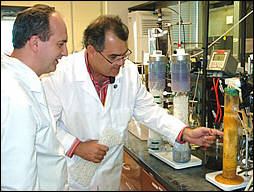



Bacteria Propel Gains in Ammonia Removal
US - Using an innovative bacterial process, Agricultural Research Service (ARS) scientists are paving the way for new, cost-efficient and large-scale methods of removing ammonia from livestock wastewater.
Bacteria Propel Gains in Ammonia Removal - US - Using an innovative bacterial process, Agricultural Research Service (ARS) scientists are paving the way for new, cost-efficient and large-scale methods of removing ammonia from livestock wastewater.
In tests with anammox--a technology that uses rare anaerobic bacteria to convert nitrite and ammonium to harmless dinitrogen gas--soil scientists Matias Vanotti and Ariel Szogi at ARS' Coastal Plains Soil, Water and Plant Research Center in Florence, S.C., have scored noteworthy results.
They're the first researchers to isolate from animal wastewater the planctomycetes bacteria used in the anammox process. They've also highlighted anammox's commercial potential by removing nitrogen from wastewater at rates similar to those obtained using conventional methods.
Short for "anaerobic ammonium oxidation," anammox was discovered in the Netherlands during the 1990s. The process is more energy-efficient than traditional biological nitrogen-removal systems because only part of the ammonium in wastewater needs to be nitrified, and it removes ammonium without needing costly aeration or additives.
In tests in Florence and at a swine farm near Kenansville, N.C., Vanotti and Szogi achieved the high nitrogen-removal rates by improving the bacteria's environment for reproduction. The bacteria's slow multiplication makes their cultivation difficult. The scientists' isolation of the bacteria from wastewater during these tests may make possible economical treatments for high-ammonia effluents, because it shows that it may not be necessary to cultivate the bacteria off-site. Vanotti added that although the researchers have used anammox to remove up to 500 grams of nitrogen per cubic meter daily from wastewater, their goal is to triple this rate within the next year.
The scientists have also launched a cooperative three-year project with EMBRAPA, Brazil's agricultural research agency, to develop a new-generation, cost-effective anammox-based treatment of livestock wastewater. Vanotti said this treatment may reduce nitrogen-treatment costs four-fold.
He discussed the anammox results earlier this week at the annual international meeting of the American Society of Agricultural Engineers, in Tampa, Fla.
Source: USDA Agricultural Research Service - 22nd July 2005
 Soil scientists Ariel Szogi (left) and Matias Vanotti examine a packed-bed bench reactor containing the anammox bacteria immobilized in polymer gel beads. Image courtesy Matias Vanotti. |
They're the first researchers to isolate from animal wastewater the planctomycetes bacteria used in the anammox process. They've also highlighted anammox's commercial potential by removing nitrogen from wastewater at rates similar to those obtained using conventional methods.
Short for "anaerobic ammonium oxidation," anammox was discovered in the Netherlands during the 1990s. The process is more energy-efficient than traditional biological nitrogen-removal systems because only part of the ammonium in wastewater needs to be nitrified, and it removes ammonium without needing costly aeration or additives.
In tests in Florence and at a swine farm near Kenansville, N.C., Vanotti and Szogi achieved the high nitrogen-removal rates by improving the bacteria's environment for reproduction. The bacteria's slow multiplication makes their cultivation difficult. The scientists' isolation of the bacteria from wastewater during these tests may make possible economical treatments for high-ammonia effluents, because it shows that it may not be necessary to cultivate the bacteria off-site. Vanotti added that although the researchers have used anammox to remove up to 500 grams of nitrogen per cubic meter daily from wastewater, their goal is to triple this rate within the next year.
The scientists have also launched a cooperative three-year project with EMBRAPA, Brazil's agricultural research agency, to develop a new-generation, cost-effective anammox-based treatment of livestock wastewater. Vanotti said this treatment may reduce nitrogen-treatment costs four-fold.
He discussed the anammox results earlier this week at the annual international meeting of the American Society of Agricultural Engineers, in Tampa, Fla.
Source: USDA Agricultural Research Service - 22nd July 2005








